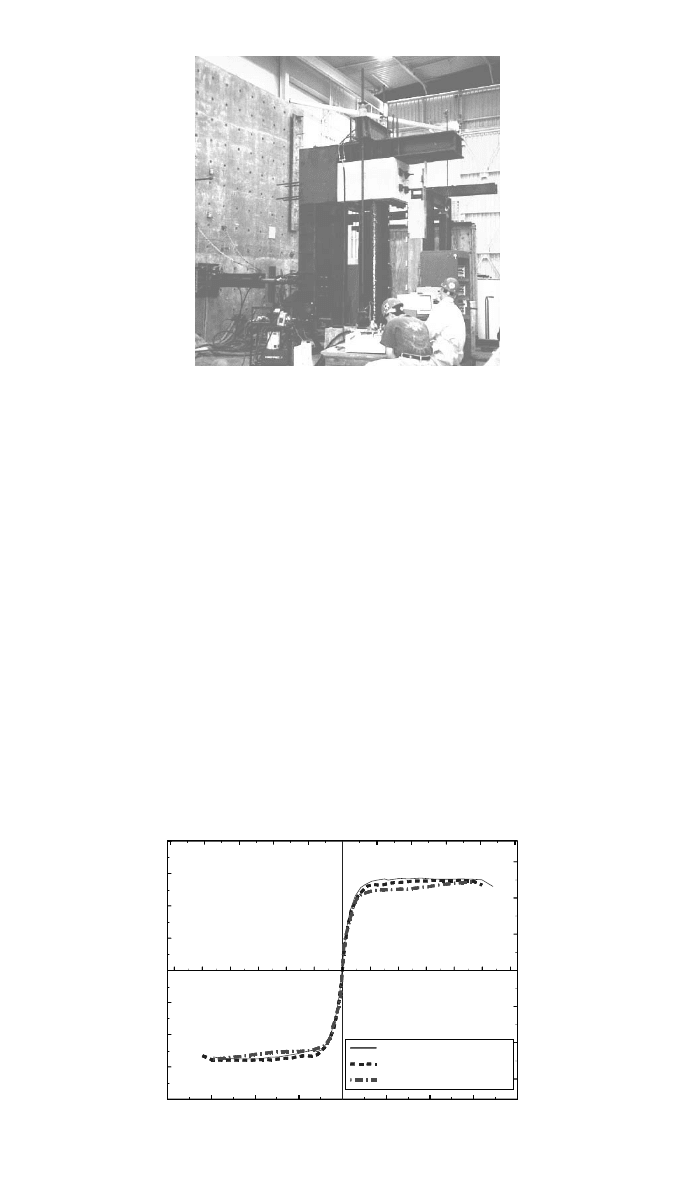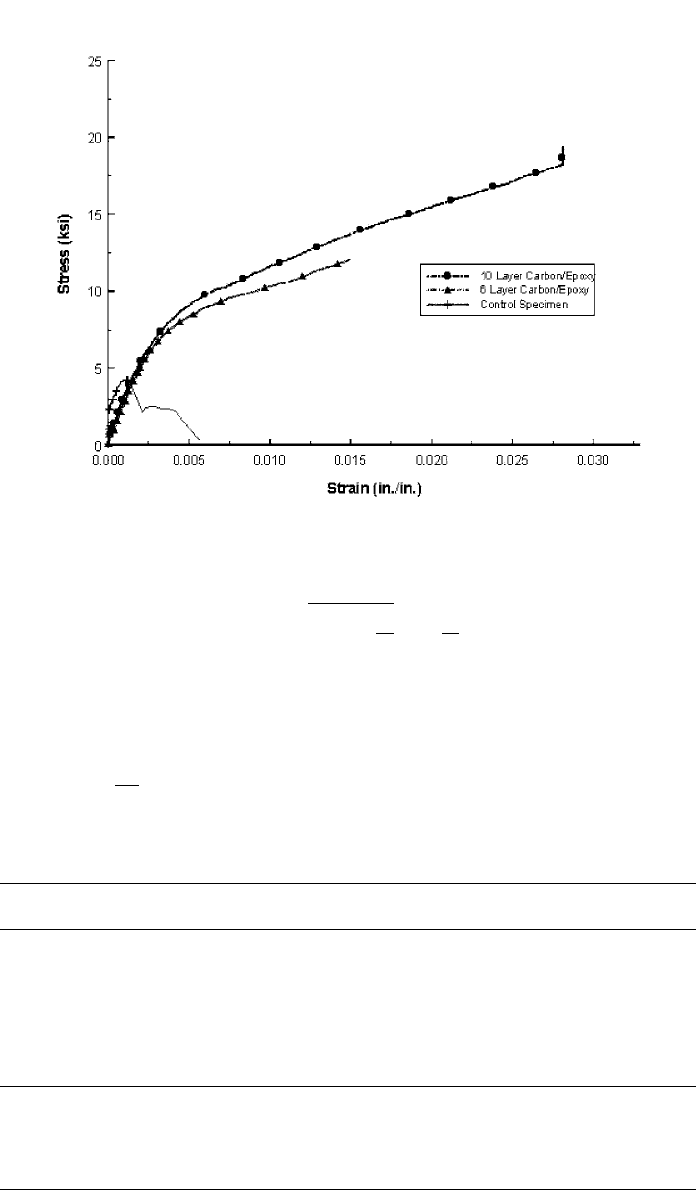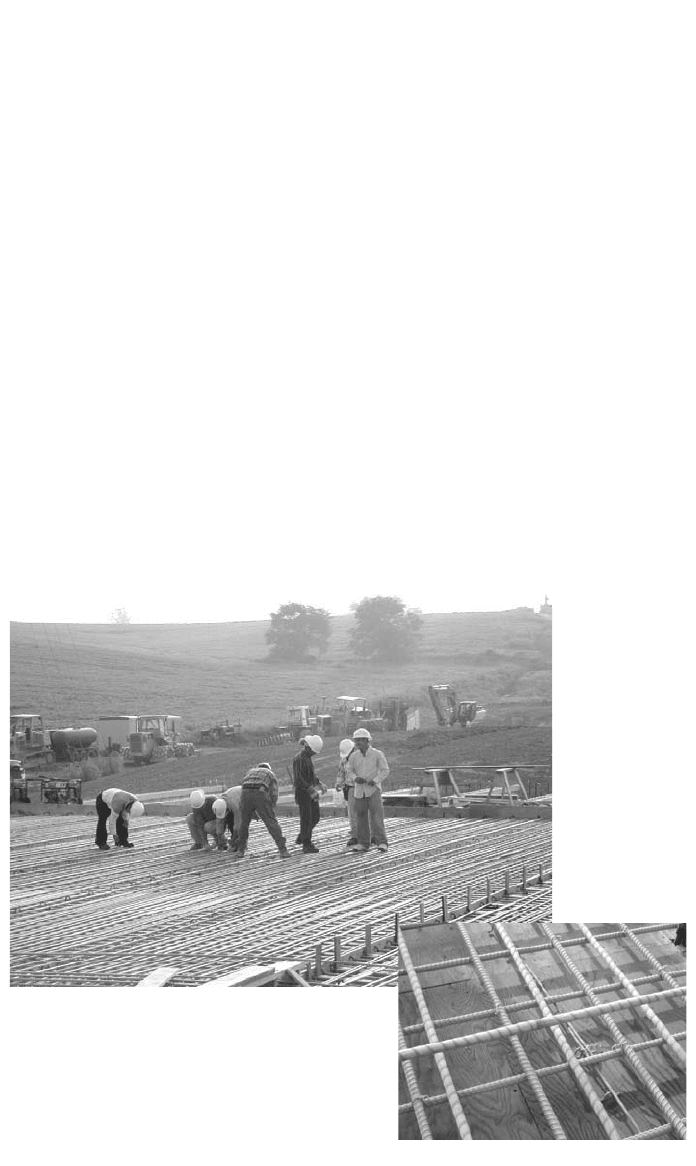Kutz M. Handbook of materials selection
Подождите немного. Документ загружается.


1392 COMPOSITES IN CONSTRUCTION
of this subject, the reader is referred to two design textbooks, one by Hollaway
and Head (2001) and one by Hollaway and Leeming (1999).
Shear and Torsional Strengths Upgrade. As mentioned earlier, the shear
strength of reinforced and unreinforced concrete and masonry members can be
upgraded using external FRP composite laminates. The previous procedures
dealing with flexural strength upgrade assumed that the engineer has checked
the shear capacity of the member, and if the member is deficient in shear, ad-
ditional FRP laminates should be applied. Studies on the torsion straightening
of reinforced concrete beams are scarce. The first pilot study on confirming the
validity of upgrading the torsional capacity of reinforced concrete rectangular
beams using FRP laminates was reported recently by Ghobarah et al. (2001).
Comprehensive studies on the use of FRP laminates to increase the shear
capacity of reinforced concrete columns and beams are reported by Haroun et
al. (1999) and Kachlakev et al. (2000), respectively.
Circular Sections. According to ICBO AC125 (ICBO, 2001b), the nominal
shear strength gain for circular reinforced concrete members of diameter D is
given by
2
V ⫽ 2.25t ƒ D sin
(23)
sj ƒ j
where V
sj
⫽ shear strength enhancement provided by FRP composite laminates,
lb (N)
t
ƒ
⫽ composite laminate thickness
ƒ
j
⫽ allowable laminate stress ⫽ 0.004E
j
ⱕ
ƒ
uj
⫽ reduction factor (refer to Table 3)
E
j
⫽ composite laminate tensile modulus
ƒ
uj
⫽ ultimate tensile strength of the composite laminate
⫽ angle of fiber orientation relative to the member axis
Rectangular Concrete Beams or Columns Sections. According to ICBO
AC125 (ICBO, 2001b), the estimated shear strength gain for rectangular concrete
cross sections or a depth H, parallel to the direction of the applied shear load is
given by
2
V ⫽ 2.86t ƒ h sin
ⱖ 75⬚ (24)
sj ƒ j
where V
sj
⫽ shear strength enhancement provided by FRP composite laminates,
lb (N)
t
ƒ
⫽ composite laminate thickness
ƒ
j
⫽ allowable laminate stress ⫽ 0.004E
j
ⱕ
ƒ
uj
⫽ reduction factor (refer to Table 3)
E
j
⫽ composite laminate tensile modulus
ƒ
uj
⫽ ultimate tensile strength of the composite laminate
H
⫽ cross-sectional dimension parallel to the applied shear force
⫽ angle of fiber orientation relative to the member axis
For the composites to perform effectively, the corner of rectangular or square
concrete section must be rounded using mechanical grinders or other appropriate

2 CONSTRUCTION APPLICATIONS OF COMPOSITES 1393
Fig. 27 Minimum radius of 0.75 in. (20 mm) for noncircular columns is required before the ap-
plication of FRP composites. (Courtesy of Professor M. Haroun, University of California, Irvine)
techniques to a minimum radius of 0.75 in. (20 mm) before the application of
the FRP laminate to the pretreated concrete surfaces (Fig. 27).
Rectangular Masonry Wall Sections. According to section 7 of the ICBO
AC125 (ICBO, 2001b), the nominal shear strength gain for rectangular masonry
wall sections of depth H parallel to the applied shear load is given by
2
V ⫽ 2t ƒ H sin
(25)
sj ƒ j
for composites applied at two sides
2
V ⫽ 0.75t ƒ H sin
(26)
sj ƒ j
for composites applied at one side only with
ⱖ 75⬚. Equations 25 and 26
assume that adequate anchorage is provided by bonding to the wall ends. In
addition, it is recommended to use a special anchoring system between the
composites and the wall and foundation using metallic or composite connectors
to ensure effective shear transfer. It is also recommended to introduce appropriate
shear strength gain reduction factors.
Axial Load Capacity Upgrade. The axial (in-plane) capacity of the concrete
or masonry member can be upgraded by applying FRP composites in the direc-
tion of the applied force. For concrete members, no data is available to confirm
this application. However, for masonry walls, numerous large-scale test results
indicated that an appreciable gain in the in-plane capacity of the wall members
could be achieved by adding fibers in the directions of the applied in-plane loads.
The common method of increasing the axial capacity of concrete members
such as columns is by applying the fibers in the transverse (hoop) direction. In
this case the composite laminates are subjected to tensile stresses due to the
Poisson effect. A large number of research studies were conducted on the be-
havior of reinforced concrete columns with FRP composite jackets. An early

1394 COMPOSITES IN CONSTRUCTION
Fig. 28 Caltrans large-scale testing of highway bridge column with FRP jackets.
(Courtesy of Professor M. Haroun, University of California, Irvine)
-4.0 -3.0 -2.0 -1.0 0.0 1.0 2.0 3.0 4.0
Displacement (inch)
-160
-120
-80
-40
0
40
80
120
160
Load (Kips)
-100 -80 -60 -40 -20 0 20 40 60 80 100
-600
-400
-200
0
200
400
600
Load (KN)
Displacement (mm)
Push
Pull
Experimental
Experimental_Average
Theoretical Envelope
-12 -10 -8 -6 -4 -2 0 2 4 6 8 10 12
Ductility
Sample CS-R1
Fig. 29 Theoretical and experimental load–displacement envelope for a large-scale reinforced
column with composite jacket (Elsanadedy, 2001).
study was reported by Priestley et al. (1992) on the use of E-glass/epoxy com-
posite jackets for seismic retrofit reinforced concrete columns. Another study
was conducted by Xiao et al. (1995) on large-scale columns retrofitted with
precured shell composite laminates. A comprehensive report prepared for the
California Department of Transportation (Caltrans) on retrofitting reinforced
concrete bridge columns using different composite systems was presented by
Haroun et al. (1999). In this report, both circular and rectangular large-scale
columns were evaluated for different retrofit applications including lap-splice
enhancement, shear enhancement, and flexural enhancement (Figs. 28 and 29).
Currently, a comprehensive experimental and theoretical program is conducted
as a joint research project between the University of California at Irvine and
California State University at Fullerton. In this program a total of 110 large-

2 CONSTRUCTION APPLICATIONS OF COMPOSITES 1395
Fig. 30 Samples of reinforced and unreinforced column specimens (Youssef, 2001).
scale reinforced and reinforced concrete column specimens with different cross-
sectional areas including rectangular, square, circular, hexagonal, and octagonal
have been tested (Fig. 30). A sample of the experimental stress–strain relations
for confined and unconfined columns is shown in Fig. 31. Tables 4 and 5 present
summaries for full-scale test results of rectangular, hexagonal, and octagonal
column specimens tested in this program. A description of the testing program
is presented by Haroun et al. (2000).
Design Procedures. The ICBO AC125 (ICBO, 2001b) has established ana-
lytical procedures to predict the strength gain of concrete members transversally
reinforced with FRP composite jackets. For circular columns, an equation based
on the Mander model (Mander et al., 1988) is adopted. The equation requires
that the aspect ratio of the repaired column cross section does not exceed 1.5,
otherwise a special analysis is required. According to section 7 of the ICBO
AC125 (ICBO, 2001b), the concrete confined compressive strength, , of a
ƒ
⬘
cc
circular column jacketed with composites in the hoop direction is given by

1396 COMPOSITES IN CONSTRUCTION
Fig. 31 Experimental stress–strain curves for confined with FRP and
unconfined circular columns (Youssef, 2001).
Table 4 Rectangular Specimens Summary Test Results
No. of
(0) Plies
Unconfined
Stress (ksi)
Unconfined
Capacity (kips)
Confined
Stress (ksi)
Confined
Capacity (kips)
Percent Increase
in Capacity
E-Glass / Epoxy Confined Specimens
3 4.23 634.32 5.02 753.00 18.71
4 4.23 634.32 5.47 820.50 29.35
7 4.23 634.32 6.24 936.00 47.56
11 4.23 634.32 7.10 1,064.55 67.83
Carbon / Epoxy Confined Specimens
2 4.23 634.32 4.81 721.34 13.72
3 4.23 634.32 5.75 862.50 35.97
5 4.23 634.32 6.09 913.50 44.01
8 4.23 634.32 6.30 945.00 48.98
ƒ⬘ ƒ⬘
tl
ƒ⬘ ⫽ ƒ⬘ 2.25 1 ⫹7.9 ⫺ 2 ⫺ 1.25 (27)
冋册
cc co
冪
ƒ⬘ ƒ⬘
cc
where ƒ ⫽⬘
co
unconfined compressive strength of the column
ƒ
⫽⬘
cc
confined compressive strength of the column
ƒ
l
⫽ lateral confining stress ⫽ 0.26
sj
ƒ
uj
sin
2
(28)
sj
⫽
(29)
4t
ƒ
D

2 CONSTRUCTION APPLICATIONS OF COMPOSITES 1397
Table 5 Test Results of Hexagonal and Octagonal Column Specimens Confined with FRP
Composites
Specimen
Shape
No. of
(0⬚)
Plies
Unconfined
Stress
(ksi)
Unconfined
Capacity
(kips)
Confined
Stress
(ksi)
Confined
Capacity
(kips)
Percent
Increase in
Capacity
E-Glass / Epoxy Confined Specimens
Hexagonal 6 3.23 472.73 9.53 1392.61 194.59
Octagonal 6 3.05 485.16 9.85 1566.64 322.91
Carbon / Epoxy Confined Specimens
Hexagonal 4 3.23 472.73 8.76 1280.73 170.92
Octagonal 4 3.05 485.16 9.53 1516.92 312.66
ƒ
uj
⫽ ultimate tensile strength of the composite laminates
t
ƒ
⫽ thickness of the composite jacket
D
⫽ column’s diameter
⫽ angle of fiber orientation relative to the member axis ⱖ 75⬚ (the
maximum efficiency for this application is achieved at
⫽ 90⬚).
For a rectangular column, a similar expression is used as follow:
2
ƒ⬘ ⫽ ƒ⬘(1 ⫹ 1.5
cos
) (30)
cc csj
where
B
⫹ H
⫽ 2t (31)
sj ƒ
BH
and B, H are the cross-sectional dimensions of the column.
It should be noted that the above equations are based on a confinement model
for concrete with steel jackets, which behaves differently than FRP composites.
For this reason, several models were proposed to account for the unique prop-
erties of composite jackets. One of the early models was proposed by Almusal-
lam and Alsayed (1995). The model proved to be effective in predicting the
behavior of concrete axial members confines with FRP composites. We recom-
mend reviewing the development of the current model to account for the linear
nature of FRP composites. In 1997, Mirmiran followed the same path and de-
veloped a simple model based on small and medium unreinforced circular col-
umn specimens. At the present, the use of the Mirmiran model is highly
recommended for predicting the strength of ‘‘circular’’ concrete axial members
with external composite jackets. This model was developed only for circular
concrete columns in which the axial response is bilinear with no descending
branch. According to this model, the confined compressive strength of a circular
axial member with composite jacket applied in the hoop direction is given by
the following equation:

1398 COMPOSITES IN CONSTRUCTION
Fig. 32 Successful prediction of the stress–strain behavior of FRP-jacketed unreinforced
concrete cylinder using Mirmiran model (Eq. 32).
(0 587)
ƒ⬘ ⫽ ƒ⬘ ⫹ 4.269ƒ (32)
cc co l
Figure 32 shows the effectiveness of the Mirmiran model (1997) in predicting
the experimental stress–strain curve of a circular standard concrete cylinder
6 in.
⫻ 12 in. (152 mm ⫻ 304.8 mm).
Additional design information on predicting the ductility enhancement of cir-
cular and rectangular columns, and the lap splice confinement gain is described
in the ICBO AC125 (ICBO, 2001b) document. The structural engineer is also
referred to a useful design textbook by Priestley et al. (1995). As mentioned
earlier, the Mirmiran model is only proven to be effective for columns with
circular cross sections, and for columns with other geometries, special models
are under development at the University of California at Irvine and will be
available in the near future.
Durability and Long-Term Performance of Composite Repair Systems
One of the major issues facing the civil engineer when deciding the use of
polymer composites in construction applications is durability and long-term per-
formance. For that reason, active programs addressing this subject were initiated
by different state and federal agencies, as well as professional organizations such
as the U.S. Federal Highway Administration (FHWA), the California Department
of Transportation (Caltrans), the International Conference of Building Officials
(ICBO), and many other organizations.
Pioneering efforts regarding the durability of FRP composites for infrastruc-
ture applications were initiated by Caltrans as a joint project with the Aerospace

2 CONSTRUCTION APPLICATIONS OF COMPOSITES 1399
Fig. 33 FRP composite reinforced bridge deck. (Courtesy of Hughes Brothers Company)
Corporation (Sultan et al., 1998; Steckel et al., 1999) for composite repair for
highway bridge columns. For general building applications, a similar program
was developed by the ICBO-ES and is described in details in Tables 1 and 20
of the ICBO AC125 (ICBO, 2001b).
2.3 Internal Reinforcement of Concrete Members Using FRP
Composites
FRP composites can also be used as an internal reinforcement for concrete and
masonry members. Currently, FRP internal reinforcements are produced in sev-
eral forms, such as (1) FRP rebars and grid and (2) FRP prestressing cables.
There are several applications where composites are the preferred choice as
internal reinforcement to concrete and masonry, including:
1. Corrosion environments [e.g., waterfront and marine structures, desali-
nation plants, parking garages and bridges exposed to deicing salts (Fig.
33), and others]
2. Structural members of magnetic resonance imaging (MRI) in hospitals,
due to the electromagnetic transparency of composites
3. Electrical applications of E-glass composites internal reinforcement due
to its nonconductivity properties that contributes in avoiding electrical-

1400 COMPOSITES IN CONSTRUCTION
Fig. 34 GFRP and CFRP reinforcing rebars.
Fig. 35 Comparison between steel and FRP composite rebars
mechanical properties (lower bound).
related hazards and interference at high-voltage environments (e.g., re-
inforced concrete power poles, foundations of structural systems in power
stations, etc.)
The common form of composite internal reinforcement is FRP rebars made
from E-glass (GFRP) and carbon-based composites (CFRP) (Fig. 34). FRP com-
posite rebars are available in standard lengths and diameter grids. According to
ACI440 (2001), the tensile strength of commercially produced FRP rebars varies
from 70 to 230 ksi (483 to 1600 MPa) for GFRP and from 87 to 535 ksi (600
to 3690 MPa) for CFRP. The longitudinal modulus of elasticity ranges from 5.1
to 7.4 ksi (35 to 51 GPa) for GFRP and from 15.9 to 84
⫻ 10
3
ksi (120 to 580
GPa). The ranges for rupture strain for GFRP and CFRP rebars are 1.2–3.1%,
and 0.5–1.7%, respectively. Figure 35 presents a comparison between the me-
chanical properties of two types of FRP internal reinforcement as compared to
conventional steel reinforcing bars.

2 CONSTRUCTION APPLICATIONS OF COMPOSITES 1401
An early study on the use of FRP composites internal reinforcement was
initiated by Bank et al. (1991). In this work, a pilot experimental study on the
use of FRP grids and gratings as internal reinforcements of one-way concrete
slabs was conducted.
The use of GFRP rebars as internal reinforcement for concrete slabs and
beams was first initiated in United States at West Virginia University (Faza,
1991). Over the past few years, a number of studies on the durability and long-
term performance of FRP internal reinforcement were reported (e.g., GangaRao
and Vijay, 1997; Sen et al., 1998; Porter et al., 1995, Alsayed et al., 2001). The
majority of the durability studies concluded the sensitivity of GFRP reinforcing
materials to alkaline environment found in fresh concrete. The strength degra-
dation of GFRP rebars can reach values up to 75%, while the stiffness degra-
dation, in many cases, can reach to a value up to 20% (ACI440, 2001).
For this reason, it is the author’s recommendation to limit the use of GFRP
as primary reinforcement in a high pH alkaline environment to low stress level
exposure to minimize the possibility of the development of microcracks in the
matrix, which opens the doors for alkaline attack of the E-glass. Another alter-
native is using alkaline-resistant (AR) glass fibers, although the cost may be
higher relative to E-glass fibers. For heavier stress environments, carbon-based
composite reinforcements are highly recommended. Again the cost may be the
issue, but the reliability in this particular environment is higher.
For a comprehensive coverage of the construction and design aspects of FRP
composite internal reinforcement of concrete members, the reader is referred to
a recent document published by the American Concrete Institute (ACI440.1R-
01, 2001).
2.4 All-Composites Structural Applications
In addition to the repair and reinforcement application of composites in con-
struction, composite materials are being used to build the entire structure such
as warehouses, buildings, highway bridge decks, and other civil engineering
structures. One of the popular types of composites in construction applications
is pultruded composites. For decades, pultruded fiber-reinforced polymeric
(PFRP) composites have been used as secondary structural members in several
construction applications such as petrochemical plants plate forms, cooling tower
structures, and in water and wastewater treatment plants applications. The pul-
trusion process is a continuous manufacturing process where the saturated fibers
are pulled through heated die using continuous pulling equipment. The hardening
or gelation of the resin is initiated by the heat from the die producing a cured
rigid pultruded profile that is cut to length by an automated saw (refer to Fig.
36). Pultrusion is considered to be the only closed-mold process that allows for
combining a variety of reinforcement types and hybrids in the same section.
Most of the commercially produced PFRP structural shapes are composed of
multilayers of surfacing veil or Nexus, continuous fibers (roving), and continu-
ous strand mat. The typical volume fraction of fibers for ‘‘off-the-shelf’’ sections
is in the range of 40–45%. A variety of structural profiles (open and closed
web) are now available similar to steel sections (H, I, C, L, . . .). The major
reinforcements of these sections are concentrated in the longitudinal direction
of the section with minimum reinforcement in the transverse direction. The most
